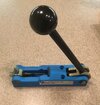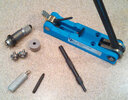So I full length resized 2500 or so 223 cases with a LEE full length sizer die.
I removed the expander mandrel and replaced it with a pistol de-cap rod so the necks would not be expanded. I based this on a article I read on making match ammo for a m1a by ensuring all operations were concentric to their appropriate features.
I went to swage the primer pockets on the LEE swager die and found the support rod would not enter the case mouth. I am using the right rod, it goes in the regular sizes 223 brass.
I feel I have ALOT of neck tension now and don't know what to do.
I think the m die will open up the neck for loading no issues.
So Two question
1. Will this much neck tension affect accuracy negatively
2. How should I go about swage the primer pockets as this is all military brass?
I removed the expander mandrel and replaced it with a pistol de-cap rod so the necks would not be expanded. I based this on a article I read on making match ammo for a m1a by ensuring all operations were concentric to their appropriate features.
I went to swage the primer pockets on the LEE swager die and found the support rod would not enter the case mouth. I am using the right rod, it goes in the regular sizes 223 brass.
I feel I have ALOT of neck tension now and don't know what to do.
I think the m die will open up the neck for loading no issues.
So Two question
1. Will this much neck tension affect accuracy negatively
2. How should I go about swage the primer pockets as this is all military brass?



